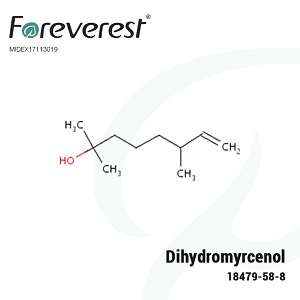Dihydromyrcenol
Dihydromyrcenol presents as a colourless liquid, characterised by a lavender fragrance reminiscent of lemon. It is typically prepared via two primary methods:
- Chlorination and Hydrolysis: One process involves the chlorination of Dihydromyrcene, followed by hydrolysis in alkaline water.
- Esterification and Saponification: The alternative method entails the esterification of dihydromyrcene using acetic acid or formic acid, subsequently producing dihydromyrcenol through saponification and hydrolysis under alkaline conditions (Germany Patent: 1668280).
Dihydromyrcenol has established itself as a significant flavouring and fragrance ingredient. It is extensively incorporated into daily chemical fragrance formulations, particularly in soap manufacturing, where its content can reach up to 20%.
Soviet spice experts previously conducted research on the flavour quality of mixtures containing Dihydromyrcenol and Myrcenyl Acetate. The study’s findings indicated that Dihydromyrcenol exhibited the optimal flavour quality when Myrcenyl acetate contents exceeded 10%. Currently, Dihydromyrcenol is widely used in daily chemical fragrances, especially for soaps, with concentrations reaching up to 20%.
Substance Identification
| Synonyms | Dimyrcetol | 2,6-Dimethyl-7-octen-2-ol | Dihydromyrcenate | Myrcetol | Dimyrcetal |
| CAS | 18479-58-8 |
| EINECS | 242-362-4 |
| FEMA | N/A |
| HS.CODE | 290619 |
| Molecular Formula | C10H20O |
| Moleclar Weight | 156.27 |
Toxicological Information
| LD50 oral, rat | 3.6g/kg min |
| LD50 dermal, rabbit | 5g/kg min |
Application & Uses
- Perfumery Ingredient: An essential raw material for citrus and lime-type fragrance compositions.
- Daily Chemical Fragrances: Widely incorporated as a key fragrance component in daily chemical products, notably soaps.
- Citronellol Synthesis: Serves as a vital raw material for the synthesis of Citronellol.
Features & Benefits
- Appearance: A colourless, transparent liquid.
- Solubility:
- Soluble in 55% alcohol at 25℃, with a ratio of 1:4 to 1:6.5.
- Soluble in kerosene, alcohols, and paraffin oil.
- Insoluble in water.
Sales Specification
| ITEM | VALUE |
|---|---|
| Appearance | Colorless liquid |
| Odor | Lemon, lavender |
| Color | No.4 max |
| Purity, G.C., % | 99 min |
| Refractive Index, @ n20/D | 1.439 to 1.443 |
| Acid Value, mgKOH/g | 1.0 max |
| Solubility, @ 25°C | Soluble in 4~6 volumes of 55% alcohol |
| LD50 oral, rat | 3.6g/kg min |
| LD50 dermal, rabbit | 5g/kg min |
GHS Hazard Statements
| H-Code | H227/315/319 |
| P-Code | P210/264/280 |
| Response | P302+P352 P305+P351+P338 P332+P313 P337+P313 P370+P378 |
| Storage | P403+P235 |
| Disposal | P501 |
Storage
- do not store in close proximity to excessive heat, open flames, strong acids or strong bases.Store in cool place
- keep container tightly closed in a dry and well-ventilated place
Relation Products
Relation Articles
Remark
Start Purchasing
-
Minimum Order Quantity
Quote required -
Lead Time
Quote required -
Available Incoterms
Quote required -
Regional Availability
Quote required
